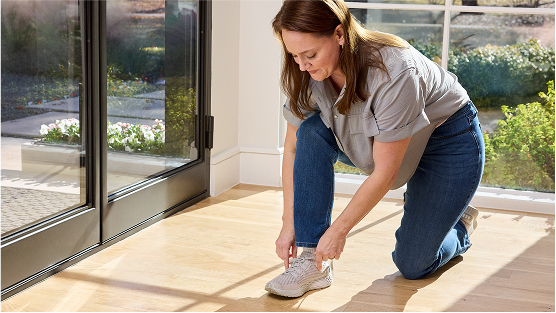Getting started with ESG
Your weight loss journey is unique to you and your body, which is why it’s important to ask your doctor if ESG is an option for you. Our education specialists can also help answer your questions.
About the ESG procedure
- ESG is an endoscopic, incisionless procedure performed by a doctor who sutures the stomach with a specialized device.
- ESG reduces the stomach size by approximately 70% to 80% using six to eight sutures. This limits the amount of food consumed and the number of calories absorbed by the stomach. It also prolongs the time food remains in the stomach, so you feel full longer.1, 2
- Over 25,000 ESG procedures have been performed worldwide.3 If you’d like a more detailed overview of the ESG procedure, watch this video. Please note: The video includes realistic medical illustrations.

After the ESG procedure
In a study, people who had an ESG procedure typically went home the same day and returned to their daily routine in two to three days.2
- The most common side effects are gastrointestinal symptoms such as nausea, abdominal pain, vomiting, constipation, burping or diarrhea. These symptoms typically resolve within 30 to 60 days.
- ESG can be part of achieving weight loss, but it requires a lasting commitment to losing weight. To lose weight and keep it off, it’s important to live a healthy lifestyle, including eating well and staying active.

Who’s a good fit for ESG?
If you're ready for a different kind of weight loss, ESG could be a good fit. Find a doctor near you or talk to an Endura Weight Loss Solutions Education Specialist to get started.
In a study, people experienced 13.6% average total body weight loss at one year when combined with diet and lifestyle changes.2
Achieving and maintaining long term results
ESG is designed for gradual, long-lasting weight loss when combined with lifestyle changes. In a study, 68% of people who got an ESG procedure maintained 25% excess body weight loss 24 months after the procedure when they continued diet and lifestyle changes.2 Consult with your medical team, or a dietician or nutritionist, since your overall goals are unique to you and your weight loss journey.

*Individual weight loss may vary.
1. For the Overstitch Endoscopic Suturing System, you need to follow a healthy diet and exercise program to lose weight. You may not lose weight if you do not adopt healthy habits. Your doctor’s clinical team, including dietitians, nutritionists, and/or exercise trainers, should help you on your weight-loss journey.
2. Abu Dayyeh BK, Bazerbachi F, Vargas EJ, et al. Endosopic sleeve gastroplasty for treatment of class 1 and 2 obesity (MERIT): a prospective, multicentre, randomised trial. The Lancet. July 2022;400(10350): 441–451. https://doi.org/10.1016/S0140-6736(22)01280-6[OP1] [OP2]
3. Estimate based on sales data. Data on file.
Important OverStitch Endoscopic Suturing System Safety Information
ESG is performed using a suturing device called OverStitch. Learn about the risks of the OverStitch Endoscopic Suturing System & OverStitch NXT Endoscopic Suturing System (OverStitch) for bariatric surgery.
Talk with your doctor to fully understand all the risks and benefits associated with using this device. Ask your doctor whether this device is right for you.
Indications for Use:
OverStitch is for adult patients with obesity with BMI between 30-50 kg/m2. OverStitch can reduce the size of the stomach by stitching the inside. It can also fix the stomach outlet from previous bypass surgery.
When OverStitch is used to help with weight loss, you need to follow a healthy diet and exercise program. You may not lose weight if you do not adopt healthy habits.
Contraindications:
Your doctor will ask you about your medical history and perform a physical exam to decide if OverStitch is right for you. At the time of your procedure, the doctor may detect internal issues that prevent you from receiving OverStitch. For example, stomach ulcers or inflammation in the stomach may impact device placement.
You should not receive OverStitch if you: have a large hiatal hernia; have a history of bleeding in your stomach or food pipe; have a history of eating disorders; are pregnant; have bleeding disorders or are on blood thinners.
Warnings:
Talk to your doctor if you develop major, continued upper abdominal or back pain with difficulty breathing at any time after getting OverStitch.
OverStitch contains nickel. Nickel may cause an allergic reaction in people with nickel sensitivity.
Potential Risks:
Breathing any foreign object or substance such as food, saliva, or stomach contents into your lungs; Intestine blockage; Switching to a different type of surgery; Nausea, vomiting, dehydration; Bleeding; Infection; Swelling, redness, and pain in tissues caused by injury or damage; Damage to or a hole through the tissue around the stomach, food pipe or surrounding organs; Unintended transfer of fluid or gas from one area of the body to another; Pain; Feeling pins and needles; Buildup of fluid around the stomach; Air leaking from the lungs; Difficulty breathing; Narrowing or tightening in the stomach; Wound opening; Death
MRI Safety Information:
OverStitch can be MRI scanned under certain conditions. Scanning under other conditions may result in injury or device malfunction. Inform your doctor or MRI technician of the device before undergoing an MRI scan. This allows them to take any needed precautions.
If you have additional questions, talk with your doctor. For full safety information, visit IFU-BSCI.com.
CAUTION Rx only. U.S. Federal law restricts this device to sale by or on the order of a physician.



